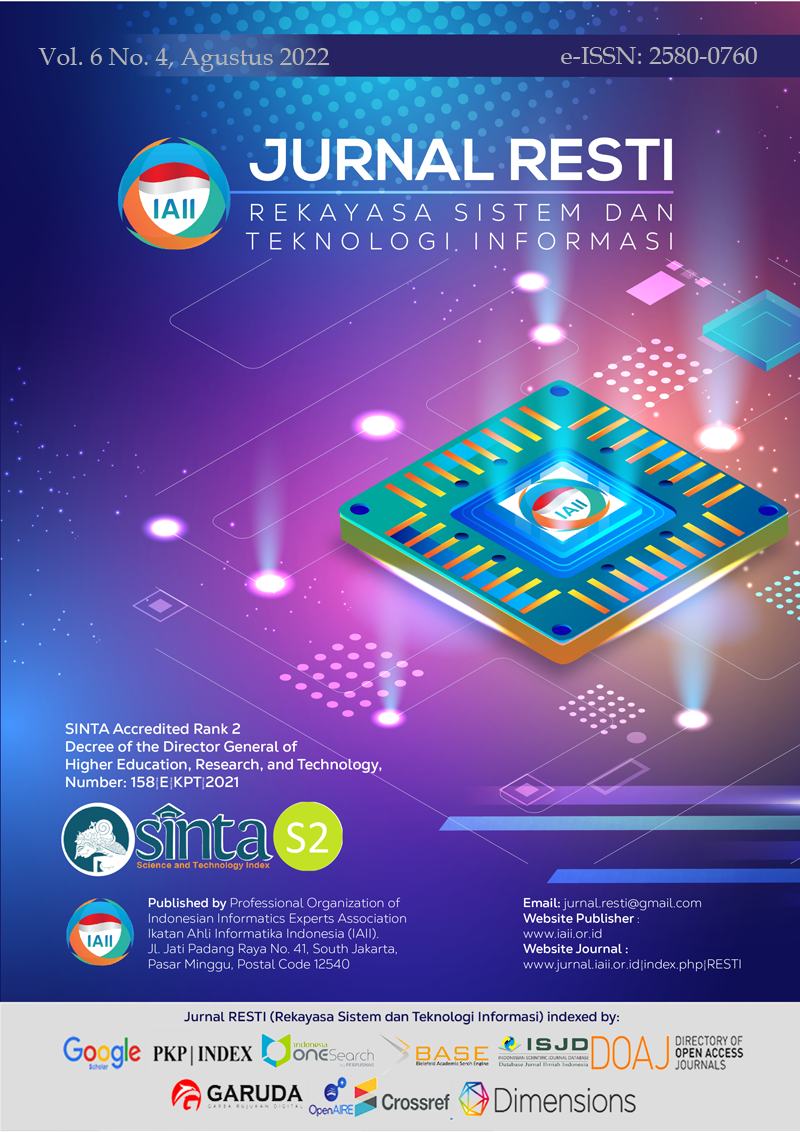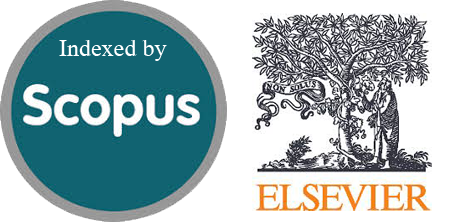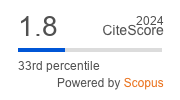QSAR Study of Larvicidal Phytocompounds as Anti-Aedes Aegypti by using GA-SVM Method
Abstract
Aedes aegypti is one of the most dangerous mosquitoes that can cause several deadly diseases, such as dengue fever, Chikungunya, Zika, and jaundice with high mortality rate. For now, no specific drug has been found that can cure the disease caused by Aedes Aegypti. One possible solution for handling this problem is to inhibit the growth and development of Aedes aegypti larvae. This study aims to implement Genetic Algorithm-Support Vector Machine to develop Quantitative Structure-Activity Relationship model for identification larvicidal phytocompounds as anti-aedes-aegypti. Hyperparameter tuning was performed to improve the performance of the models. Based on the result, we found that the best model was developed by the RBF kernel with the value of and score are 0.64 and 0.64, respectively.
Downloads
References
K. V. Lakshmi, A. V. Sudhikumar, and E. M. Aneesh, “Larvicidal activity of phytoextracts against dengue fever vector, Aedes aegypti - A review,” Plant Sci. Today, vol.5, no. 4, pp. 167–174, 2018, doi: 10.14719/pst.2018.5.4.407.
M. Javidfar and S. Ahmadi, “QSAR modelling of larvicidal phytocompounds against Aedes aegypti using index of ideality of correlation,” SAR QSAR Environ. Res., vol. 31, no. 10, pp. 717–739, 2020, doi: 10.1080/1062936X.2020.1806922.
J. E Cogan, “Dengue and severe dengue,” Who, 2018, [Online]. Available: https://www.who.int/news-room/fact-sheets/detail/dengue-and-severe-dengue.
S. Chalom et al., “Utilization of electrocoagulation for the isolation of alkaloids from the aerial parts of Stemona aphylla and their mosquitocidal activities against Aedes aegypti,” Ecotoxicol. Environ. Saf., vol. 182, no. July, p. 109448, 2019, doi: 10.1016/j.ecoenv.2019.109448.
P. Yogarajalakshmi et al., “Toxicological screening of marine red algae Champia parvula (C. Agardh) against the dengue mosquito vector Aedes aegypti (Linn.) and its non-toxicity against three beneficial aquatic predators,” Aquat. Toxicol., vol. 222, no. March, p. 105474, 2020, doi: 10.1016/j.aquatox.2020.105474.
R. Pavela, “Essential oils for the development of eco-friendly mosquito larvicides: A review,” Ind. Crops Prod., vol. 76, pp. 174–187, 2015, doi: 10.1016/j.indcrop.2015.06.050.
R. Pavela, “History, presence and perspective of using plant extracts as commercial botanical insecticides and farm products for protection against insects - A review,” Plant Prot. Sci., vol. 52, no. 4, pp. 229–241, 2016, doi: 10.17221/31/2016-PPS.
M. R. S. Silvério, L. S. Espindola, N. P. Lopes, and P. C. Vieira, “Plant natural products for the control of Aedes aegypti: The main vector of important arboviruses,” Molecules, vol. 25, no. 15, 2020, doi: 10.3390/molecules25153484.
S. Vilar, G. Cozza, and S. Moro, “Medicinal Chemistry and the Molecular Operating Environment (MOE): Application of QSAR and Molecular Docking to Drug Discovery,” Curr. Top. Med. Chem., vol. 8, no. 18, pp. 1555–1572, 2008, doi: 10.2174/156802608786786624.
M. R. Keyvanpour and M. B. Shirzad, “An Analysis of QSAR Research Based on Machine Learning Concepts,” Curr. Drug Discov. Technol., vol. 18, no. 1, pp. 17–30, 2021.
C. B. R. Santos et al., “A SAR and QSAR study of new artemisinin compounds with antimalarial activity,” Molecules, vol. 19, no. 1, pp. 367–399, 2014, doi: 10.3390/molecules19010367.
A. Beheshti, E. Pourbasheer, M. Nekoei, and S. Vahdani, “QSAR modeling of antimalarial activity of urea derivatives using genetic algorithm-multiple linear regressions,” J. Saudi Chem. Soc., vol. 20, no. 3, pp. 282–290, 2016, doi: 10.1016/j.jscs.2012.07.019.
J. P. Doucet, E. Papa, A. Doucet-Panaye, and J. Devillers, “QSAR models for predicting the toxicity of piperidine derivatives against Aedes aegypti,” SAR QSAR Environ. Res., vol. 28, no. 6, pp. 451–470, 2017, doi: 10.1080/1062936X.2017.1328855.
M. Fajar Rizqi, R. Rendian Septiawan, and I. Kurniawan, “Implementation of Simulated Annealing-Support Vector Machine on QSAR Study of Indenopyrazole Derivative as Anti-Cancer Agent,” 2021 9th Int. Conf. Inf. Commun. Technol. ICoICT 2021, no. Icidm, pp. 662–668, 2021, doi: 10.1109/ICoICT52021.2021.9527416.
M. Fajar Rizqi, R. Rendian Septiawan, and I. Kurniawan, “Implementation of Simulated Annealing-Support Vector Machine on QSAR Study of Indenopyrazole Derivative as Anti-Cancer Agent,” 2021 9th Int. Conf. Inf. Commun. Technol. ICoICT 2021, pp. 662–668, 2021, doi: 10.1109/ICoICT52021.2021.9527416.
H. F. Azmi, K. M. Lhaksmana, and I. Kurniawan, “QSAR Study of Fusidic Acid Derivative as Anti-Malaria Agents by using Artificial Neural Network-Genetic Algorithm,” 2020 8th Int. Conf. Inf. Commun. Technol., 2020.
F. Rahman, K. M. Lhaksmana, and I. Kurniawan, “Implementation of Simulated Annealing-Support Vector Machine on QSAR Study of Fusidic Acid Derivatives as Anti-Malarial Agent,” 2020 6th Int. Conf. Interact. Digit. Media, 2020.
A. Arwansyah, A. R. Arif, G. Syahputra, S. Sukarti, and I. Kurniawan, “Theoretical studies of Thiazolyl-Pyrazoline derivatives as promising drugs against malaria by QSAR modelling combined with molecular docking and molecular dynamics simulation,” SAR QSAR Environ. Res., vol. 47, no. 12, pp. 988–1001, 2021.
I. Kurniawan, R. Wardhani, M. Rosalinda, and N. Ikhsan, “QSAR Study for Prediction of HIV-1 Protease Inhibitor Using the Gravitational Search Algorithm–Neural Network (GSA-NN) Methods,” Lontar Komput. J. Ilm. Teknol. Inf., vol. 12, no. 2, pp. 62–77, 2021.
A. Arwansyah et al., “Molecular modelling on SARS-CoV-2 papain-like protease: an integrated study with homology modelling, molecular docking, and molecular dynamics simulations,” SAR QSAR Environ. Res., vol. 32, no. 9, pp. 699–718, 2021.
A. Lambora, K. Gupta, and K. Chopra, “Genetic Algorithm- A Literature Review,” Proc. Int. Conf. Mach. Learn. Big Data, Cloud Parallel Comput. Trends, Prespectives Prospect. Com. 2019, no. 1998, pp. 380–384, 2019, doi: 10.1109/COMITCon.2019.8862255.
D. Parbat and M. Chakraborty, “A python based support vector regression model for prediction of COVID19 cases in India,” Chaos, Solitons and Fractals, vol. 138, pp. 3–7, 2020, doi: 10.1016/j.chaos.2020.109942.
C. Audet and W. Hare, “Genetic Algorithms,” Springer Ser. Oper. Res. Financ. Eng., pp. 57–73, 2017, doi: 10.1007/978-3-319-68913-5_4.
I. Ahmad, M. Basheri, M. J. Iqbal, and A. Rahim, “Performance Comparison of Support Vector Machine, Random Forest, and Extreme Learning Machine for Intrusion Detection,” IEEE Access, vol. 6, no. c, pp. 33789–33795, 2018, doi: 10.1109/ACCESS.2018.2841987.
I. Kurniawan, M. S. Fareza, and P. Iswanto, “Comfa, molecular docking and molecular dynamics studies on cycloguanil analogues as potent antimalarial agents,” Indones. J. Chem., vol. 21, no. 1, pp. 66–76, 2021, doi: 10.22146/ijc.52388.
Copyright (c) 2022 Jurnal RESTI (Rekayasa Sistem dan Teknologi Informasi)

This work is licensed under a Creative Commons Attribution 4.0 International License.
Copyright in each article belongs to the author
- The author acknowledges that the RESTI Journal (System Engineering and Information Technology) is the first publisher to publish with a license Creative Commons Attribution 4.0 International License.
- Authors can enter writing separately, arrange the non-exclusive distribution of manuscripts that have been published in this journal into other versions (eg sent to the author's institutional repository, publication in a book, etc.), by acknowledging that the manuscript has been published for the first time in the RESTI (Rekayasa Sistem dan Teknologi Informasi) journal ;








